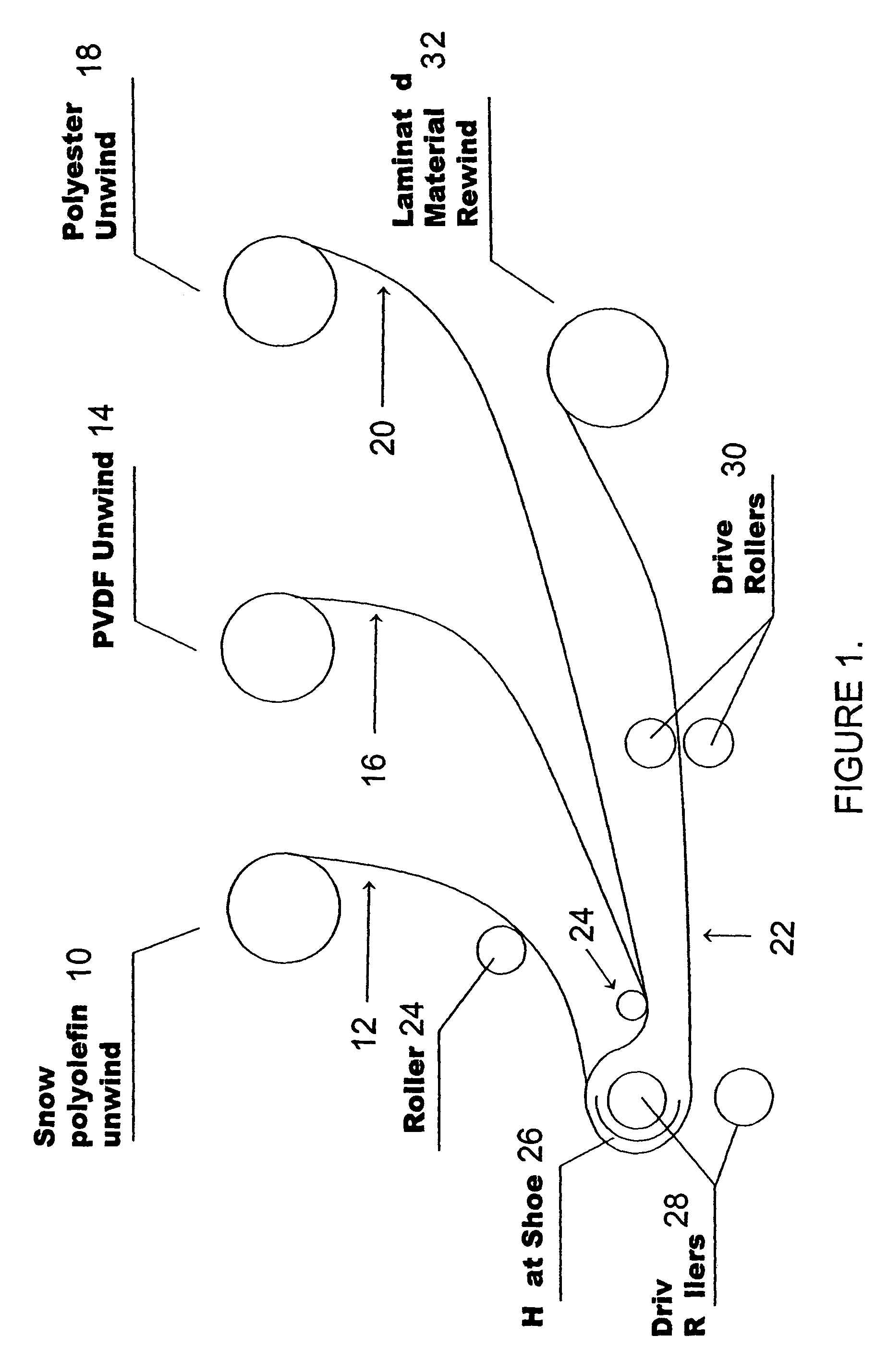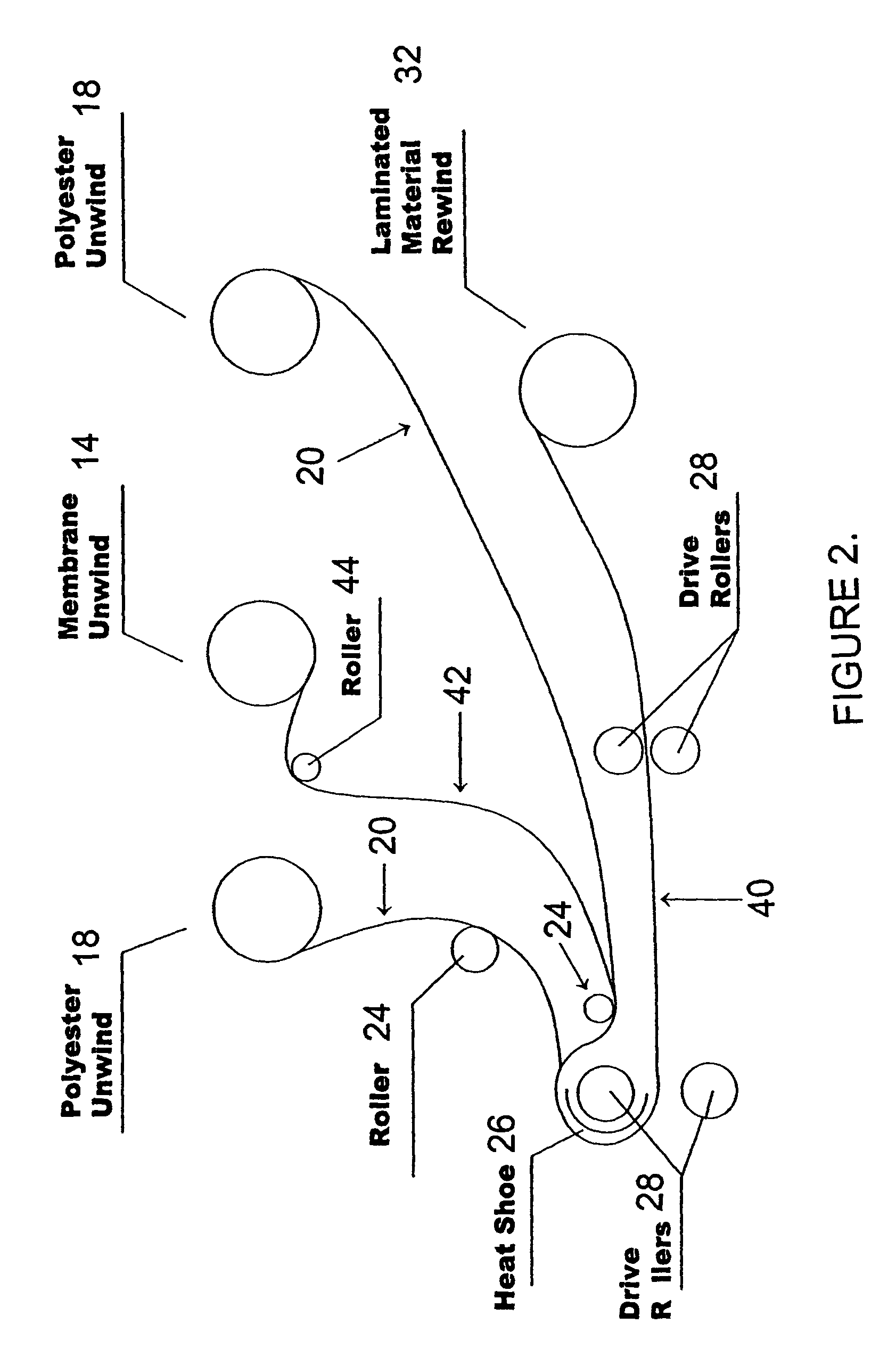Laminates of asymmetric membranes
a technology of asymmetric membranes and laminates, applied in the direction of separation processes, filtration separation, transportation and packaging, etc., can solve the problems of fragile thin membranes, adversely affecting the strength and performance of composites, and difficult handling or packaging into cartridges
- Summary
- Abstract
- Description
- Claims
- Application Information
AI Technical Summary
Problems solved by technology
Method used
Image
Examples
examples 1-2
Laminates Containing Asymmetric Polyvinylidene Fluoride Membranes
[0062]A membrane casting solution was prepared, containing 16% PVDF, 2.5% water, 15% n-butanol, 58% dimethyl formamide (DMF), 1.5% PVP (k-90) AND 7% PVP (k-30). Membrane samples were cast onto a moving belt of polyethylene coated paper using a casting knife. Following casting, the membranes were quenched in a water bath at about 65° C. After coagulation, the membranes were washed with deionized water and stored in deionized water.
[0063]A three layer composite was then assembled. The bottom layer was polyester (HOLLYTEX grade 3256, Ahlstrom Filtration, Mount Holly Springs, Pa.). The middle layer was the wet PVDF membrane made and stored as described above. The top layer was a low melting point polypropylene nonwoven material (grade 2432, from Snow Filtration, West Chester, Ohio). The layers were laminated as illustrated schematically in FIG. 1. Depending on the temperature of the upper and lower heat sources, the PVDF m...
examples 14-17
Lamination of Highly Asymmetric Polysulfone Membranes Having Different Pore Sizes
[0071]Lamination of highly asymmetric polysulfone membranes of different pore sizes (BTS-16 and BTS-30) to a Reemay type 3256 material was studied further at different lamination speeds. For the laminates thus produced, data were recorded MFP size and water flow. Lamination temperature for each laminate thus prepared was 380° F. Adhesion of the membrane to the adjacent material was consistently good in these tests. All laminate samples tested had thicknesses in the range of 6.0 to 6.5 mils. Results are shown in Table 4. The results demonstrate that the process is robust, with changes in lamination speed having little effect on MFP size and water flow.
[0072]
TABLE 4SpeedMFP SizeWater FlowExampleType(ft / min)(μm)(ml / min)14BTS-161.60.93152515BTS-161.91.09163616BTS-302.00.34 52917BTS-302.20.33 643
examples 18-23
Lamination of Highly Asymmetric Polysulfone Membranes to a Two-Component Calendared Polyester
[0073]Lamination of highly asymmetric polysulfone membranes (BTS-25) having a variety of pore sizes to various two-component calendared polyester materials (Reemay type 3256, 2055, or 2033), was studied further at different lamination speeds. For the laminates thus produced, data were recorded on MFP size and water flow rate. The indicated shoe temperature for each laminate thus prepared was 399° F. (204° C.). Adhesion of the membrane to the adjacent material was quantitatively tested using an Instron 5542 unit (available from Instron of Canton, Mass.) to measure the force required to peel back (at a 180° angle) one layer from another in a 1″-wide laminate strip. Results are shown in Table 5.
[0074]
TABLE 5SpeedMFP SizeFlow RateExampleType(ft / min)Reemay type(μm)(ml / min)18BTS-250.932560.4569319BTS-251.632560.4860020BTS-251.620330.3760021BTS-251.632560.3540022BTS-250.920330.4764323BTS-250.920550...
PUM
| Property | Measurement | Unit |
|---|---|---|
| diameter | aaaaa | aaaaa |
| diameter | aaaaa | aaaaa |
| diameter | aaaaa | aaaaa |
Abstract
Description
Claims
Application Information
 Login to view more
Login to view more - R&D Engineer
- R&D Manager
- IP Professional
- Industry Leading Data Capabilities
- Powerful AI technology
- Patent DNA Extraction
Browse by: Latest US Patents, China's latest patents, Technical Efficacy Thesaurus, Application Domain, Technology Topic.
© 2024 PatSnap. All rights reserved.Legal|Privacy policy|Modern Slavery Act Transparency Statement|Sitemap


